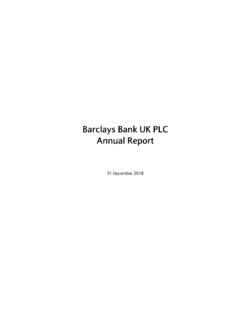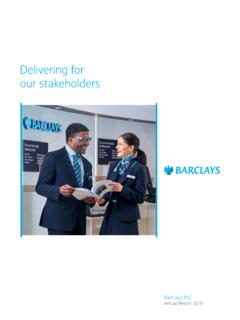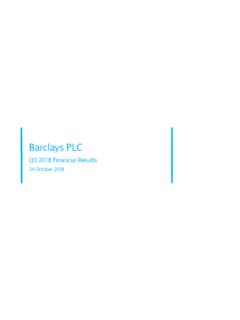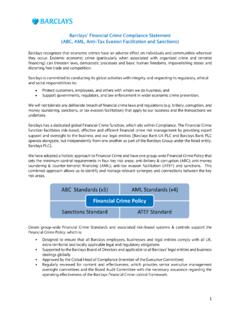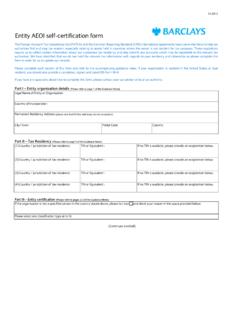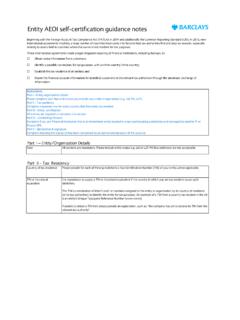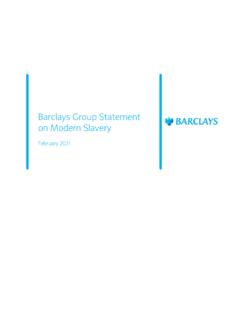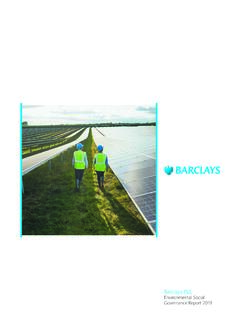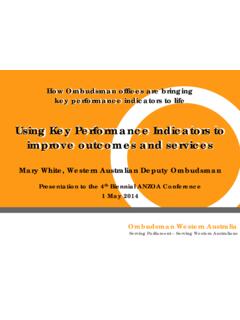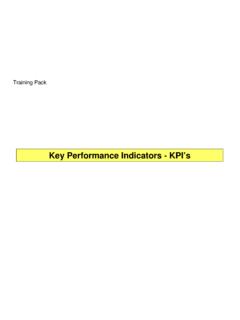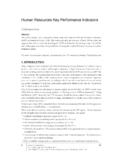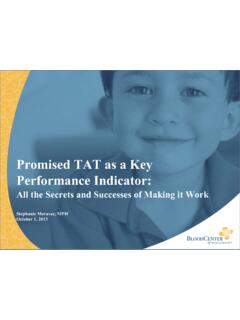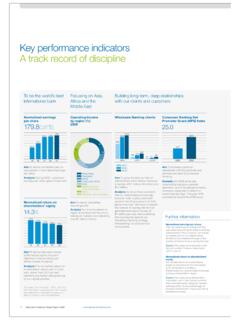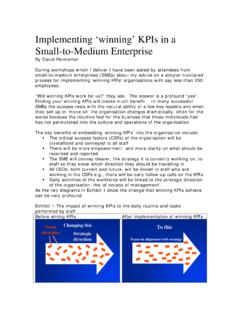Transcription of Key performance indicators A holistic approach to ...
1 Barclays PLC Strategic Report 2017 15A holistic approach to measuring successKey performance indicatorsFinancial performance metricsThe financial metrics are aligned to Barclays PLC Group financial targets, updated in Q317, and are reported quarterly as part of our financial results. Achieving our targets is consistent with our aim of generating long-term sustainable returns for the shareholders of Barclays PLC non-financial performance measuresNon-financial measures are an important element of how we evaluate our progress towards achieving our ambition of delivering a sustainable business for all our stakeholders. We focus on the impact we have on our customers and clients, colleagues, and the benefit we bring to society via our citizenship activity. These measures are underpinned by how we behave towards all our stakeholders, through our conduct and our culture.
2 To assess our performance , progress towards delivering positive outcomes for our stakeholders is informed by a number of sources including internal dashboards, regular management reporting and external measures, to help provide a balanced review of performance . We have a range of policies and guidance that can support our key outcomes for our customers and clients, colleagues and citizenship activity. performance against our strategic non-financial performance measures is one indicator of the effectiveness and outcome of aspects of certain policies and guidance. Our policies and guidance are refreshed regularly. For further details, please see our Customer and Client, Colleague and Citizenship sections. Our approach reflects the way in which management monitors the performance of the Group, allows for a holistic assessment and sets out our progress towards the strategic goals of the organisation.
3 By incorporating a broad range of financial and non-financial measures, our framework is focused on achieving positive and sustainable outcomes for our diverse group of stakeholders, and influences incentive outcomes for Barclays more on our remuneration framework in the Remuneration Report pages 93 to 116 of the Barclays PLC Annual Report and governance: performance MeasurementIn the 2016 Barclays Annual Report, we introduced our revised performance measurement framework to assess progress against our strategy, across our diverse stakeholder groups. The framework reflects a balance of key financial performance metrics and broader strategic non-financial PLC Group performance Measurement FrameworkFinancial performance metricsGroup RoTE* >9% in 2019 >10% in 2020 CET1 ratio 150-200 bps above the end point regulatory minimum levelGroup costs in 2019** Targeting cost.
4 Income ratio below 60%* excluding litigation and conduct, and based on a CET1 ratio of ** excluding litigation and conductStrategic non-financial performance measures Delivering positive outcomes for our stakeholdersCustomer and Client Building trust with our customers and clients, such that they are happy to recommend us to others Successfully innovating and developing products and services that meet their needs Offering suitable products and services in an accessible way, ensuring excellent customer and client experienceColleaguePromoting and maintaining: A diverse and inclusive workforce in which colleagues of all backgrounds are treated equally and have the opportunity to be successful and achieve their potential Engaged and enabled colleagues A positive conduct and values-based environmentCitizenship Making decisions and doing business that provides our clients, customers, shareholders, colleagues and the communities which we serve with access to a prosperous future, through our Shared Growth Ambition Proactively managing the environmental and societal impacts of our businessUnderpinned by how we behave towards all our stakeholders through our conduct and culture16 Barclays PLC Strategic Report 2017 performance indicatorsA holistic approach to measuring successApproach and governance.
5 RemunerationPerformance against our financial metrics and strategic non-financial performance measures is directly linked to executive remuneration, and also influences incentive outcomes for Barclays employees more broadly. This approach supports us in our work to deliver positive outcomes for all our stakeholders. Please refer to the Remuneration Report on pages 93 to 116 of the Barclays PLC Annual Report 2017 for further information. Financial performance metricsKey outcomes we will look to achieve include:Achieving our financial targets, consistent with our aim of generating long-term sustainable returns for the shareholders of Barclays PLC we measure success: The financial performance metrics are aligned to Barclays PLC Group financial targets, updated in Q317: Group Return on Tangible Equity (RoTE) of greater than 9% in 2019 and greater than 10% in 2020, excluding litigation and conduct, and based on a CET1 ratio of CET1 ratio of 150 200 bps above the end point regulatory minimum level Group costs, excluding litigation and conduct, of in 2019, and to have a target cost: income ratio below 60%RoTE measures our ability to generate acceptable returns for shareholders.
6 It is calculated as profit after tax attributable to ordinary shareholders, including an adjustment for the tax credit recorded in reserves in respect of other equity instruments, as a proportion of average shareholders equity excluding non-controlling interests and other equity instruments adjusted for the deduction of intangible assets and goodwill. This measure indicates the return generated by the management of the business based on shareholders tangible equity. Achieving a target RoTE demonstrates the organisation s ability to execute its strategy and align management s interests with the shareholders . RoTE lies at the heart of the Group s capital allocation and performance management CET1 ratio is a measure of the capital strength and resilience of Barclays. The Group s capital management objective is to maximise shareholder value by prudently managing the level and mix of its capital.
7 This is to ensure the Group and all of its subsidiaries are appropriately capitalised relative to their minimum regulatory and stressed capital requirements, and to support the Group s risk appetite, growth, and strategic options while seeking to maintain a robust credit proposition for the Group and its ratio expresses Barclays capital as a percentage of risk weighted assets (RWAs), as defined by the PRA, in the context of Capital Requirements Directive IV (CRD IV an EU directive prescribing capital adequacy and liquidity requirements), and is part of the regulatory framework governing how banks and depository institutions are views operating expenses as a key strategic area for banks; those which actively manage costs and control them effectively will gain a strong competitive advantage. Restructuring the cost base is a key execution priority for management and includes a review of all categories of discretionary spending and an analysis of how we can run the business to ensure that costs increase at a slower rate than cost: income ratio measures operating expenses as a percentage of total income and is used to assess the productivity of the business the Return on Tangible Equity metricSignificant strategic progress was made in 2017 with the closure of Non-Core and sell down of our stake in Barclays Africa, marking the completion of our restructuring.
8 With the closure of Non-Core, we no longer have a Core and Non-Core distinction within the Group, and hence our prior target of Group RoTE to converge with Core RoTE no longer exists. The RoTE target has been updated to reflect our commitment to continuing to execute at pace against our plan and we are confident in asserting when Barclays will start to deliver the economic performance that the Group is capable we are doingGroup Return on Tangible Equity 2017 reflected a number of one-off items including losses related to the sell down of BAGL of and a net charge of due to the re-measurement of US DTAs in Q417, as well as litigation and conduct of These items drove a Group RoTE of negative (2016: positive ). Excluding these material items, Group RoTE was How we are doingGroup Return on Tangible Equity( )% 2016 Equity Tier 1 (CET1) 2016 : Income ratio73% 2016 76%Operating Expenses* 2016 * excluding litigation and Barclays PLC Strategic Report 2017 17 CRD IV fully loaded CET1 ratioThe Group s CRD IV fully loaded CET1 ratio increased to (2016: ) driven by a decrease in RWAs of 53bn to 313bn, which was partially offset by a reduction in CET1 capital to (2016: ).
9 The 90bps improvement was driven by organic capital generation from continuing operations, the benefit of the proportional consolidation of BAGL and the rundown of Non-Core, partially offset by an adverse movement in reserves and the net impact of the re-measurement of US expenses and Cost: income ratio Group operating expenses were (2016: ). Excluding litigation and conduct charges, Group operating expenses were (2016: ), in line with 2017 guidance. The reduction in operating expenses was primarily driven by lower Non-Core related operating Group cost: income ratio was 73% (2016: 76%). For further information on the financial performance of the Group, please see p non-financial performance measuresHow we are doing: summaryWe assess progress towards the delivery of positive outcomes our customers and clients (page 18), colleagues (page 19), and citizenship activity (page 21), all underpinned by conduct and of encouragement:Customer and Client: In 2017, we continued to focus on delivering excellent customer and client experience, by offering products and services to meet their needs in an appropriate and accessible way.
10 We are encouraged by the performance of our Relationship Net Promoter Scores (NPS ), while our client ranking and market share indicators remained broadly stable across many of our international business areas, which we believe reflect the relevance of our customer and client proposition. Digital solutions can enable a convenient and secure everyday banking experience for customers and clients, and we believe this is reflected in a 7% year on year increase in the number of Barclays UK customers using our digital : We remain focused on increasing the diversity of our workforce and continuing to build an inclusive culture. We are proud of the progress we have made on the multicultural, multigenerational, LGBT and Disability pillars, and we continue to receive external recognition for our diversity and inclusion work. We also continue to focus on the positive engagement of our workforce, and are encouraged to see a 3% point improvement in our annual employee engagement survey : We are conscious of our wider stakeholders and the communities in which we operate and have performed well against our citizenship agenda, meeting our internal objectives on all six of our Shared Growth Ambition metrics.
